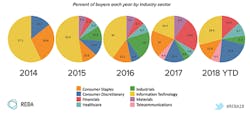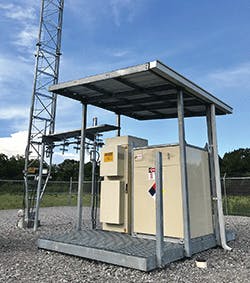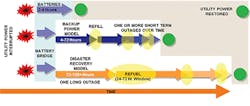Latest from Home
A recent report from the United Nations office for disaster risk reduction stated that worldwide costs of climate-related natural disasters (earthquakes, floods, hurricanes and the like) have surged to total nearly $2.9 trillion over the last 20 years1. Restoring downed grid power and communications networks in devastated areas is no easy task. With data showing an increase in the rate of these disasters, perhaps the best way forward is to continue to focus our efforts on improving disaster recovery and backup power. Innovative clean energy solutions can provide continuous backup power for the days (if not weeks) it takes to restore this critical infrastructure, enabling recovery teams to complete their work under the toughest conditions, without adding environmental impact.
Data collected since 1980 by leading global reinsurance company, Munich RE, illustrates the trend seen over the last 2 decades2. Worldwide, there has been a steady growth in the number of service-impacting events. (See Figure 1.)
Figure 1. Number of relevant natural loss events worldwide 1998-2017. (Source: https://natcatservice.munichre.com/)
Even more startling is a comparison of North American events over three 5-year time periods from 1980 until 2017. From 1980 to 1985, there were 361 service-interrupting events. Compare this to a total of 535 events during the 2000 through 2005 period, and 850 events from 2012 through 2017, and the trend becomes obvious. Though they are spread across North America, our continent is seeing significant increases in service-interrupting events. Whether one wishes to attribute that trend to climate change or not, the fact is that our teams are needing to respond to more outage events each decade. (See Figure 2.)
Figure 2. Natural loss events in North America over 3 time periods. (Source: https://natcatservice.munichre.com/)
Effective recovery from service-interrupting events includes having power and communication systems that have been designed for resiliency. Carriers and utilities have given this topic much attention in the past several years. Given the growth in climatological events, it would seem prudent to strongly consider power technologies that also decrease the amount of greenhouse gas emissions produced. Those include solar, wind, and fuel cell power — all of which generally work in conjunction with battery storage — and can be used in a hybrid system to provide ultra-reliable backup or off-grid power.
Renewable Energy Telecom Trends
According to a story in USA Today, disaster-prone areas in North America are adding more renewable energy in order to increase their storm resilience3. For example, following Hurricane Matthew, which in 2016 caused similar destruction in North Carolina as was caused by Hurricane Florence in 2018, the state worked to rebuild the system with more solar and wind energy4. Renewable power now accounts for almost 5% of its total energy production5, more than any other state other than California6.
This is a good start, but there is significant room for growth. The good news is that reports indicate that, while solar farms experienced minor damage from Hurricane Florence, these renewable energy facilities were able to come back online faster than those powered by fossil fuels7.
Across the US, as of October 2018, corporate buyers in the US had purchased 4.81 GW of renewable energy in 2018, up a full 2.03 GW (136.9%) from 2017’s mark. Of that, the telecom industry accounted for 6.5% — up from 4.8% in 20178. (See Figure 3.)
Figure 3. Percent of buyers each year by industry sector.
T-Mobile has pledged to transition to 100% renewable power for its Bellevue, Washington, headquarters by 20219. And AT&T is also pursuing an aggressive renewable energy plan10. The biggest reason corporations have now begun to pursue green energy deals is the falling cost of renewable electricity11. Since 2010, solar and onshore wind energy costs have fallen by 84% and 32%, respectively, meaning electricity from these technologies now costs about the same as coal and natural gas in several markets.
InvisiLight® Solution for Deploying Fiber
April 2, 2022Go to Market Faster. Speed up Network Deployment
April 2, 2022Episode 10: Fiber Optic Closure Specs Explained…
April 1, 2022Food for Thought from Our 2022 ICT Visionaries
April 1, 2022The big 4 telecom carriers, in addition to using solar and wind power, are using hydrogen fuel cells at many of their central offices12 as well as at critical mobile sites. (See Figure 4.) The US telecom landscape is dotted with more than 4,000 fuel cells. In the Southeast, Southern Linc is installing an LTE network utilizing 500+ fuel cells for backup power13. Fuel cell power was also a strong solution for critical telecom locations during and after 2018’s Hurricane Michael, providing more than a cumulative 2,400 hours of ongoing power for communications sites for up to 2 weeks, while utilities worked hard to repair grid service14.
Figure 4. Hydrogen fuel cells at one of Southern Linc’s LTE network sites. (Source: Plug Power)
What are the benefits of renewable energy for telecom? We already know that clean energy produces no emissions. It’s good for corporate — and global — sustainability goals, decreasing the greenhouse gas load we ask our planet to carry. Renewable energy also increases the resiliency of networks after storms. When utility grids are damaged due to wind, ice, or fallen trees, solar, battery, and fuel cells, are generally able to continue providing power. And power means critical communication lines stay operational. These DC power sources work well together in a hybrid setup connected to the DC bus. And with costs dropping — and also subsidized by Federal tax credits — clean power is cost-competitive compared to traditional diesel generators. For many sites, the question is: why NOT consider using renewable power?
Digging Into the Details of Contingency Planning
A viable site-hardening plan involves combining one or more backup power technologies in parallel, increasing the availability of the site through hybridization. For instance, a site that generally runs off AC power and is already equipped with backup batteries connected to the DC bus, would benefit from a fuel cell also connected to the DC bus to carry the site load and charge batteries when the batteries dip below a certain voltage at loss of AC power. The fuel cell power prevents the deep level of discharge on a battery string and allows the site to operate on backup power for much longer than on batteries alone. Add solar power and one has a clean solution for off-grid sites where the cost of a new commercial spur feed may be expensive and unreliable.
Backup power and disaster recovery models are significantly different due to the length of time the auxiliary power is required. Most people think of backup power covering a grid outage lasting from an hour to a few days. Disaster recovery solutions — as we see each year — are needed for a much longer span of time, generally at least 5 days, but often weeks. (See Figure 5.)
Figure 5. Outage recovery strategies by length of outage. (Source: Plug Power)
Most telecommunication sites currently utilize a combination of batteries and either a combustion generator or a fuel cell to cover their longer backup power or disaster recovery outages — sometimes solar and/or wind power for off-grid sites as well. But generators are well known for their greenhouse gas emissions15 — even with Tier 4 regulations in place. In a model in which clean power technology is favored, other options are more highly valued.
In a disaster recovery scenario, the issue becomes the need for a fueling model that is suitable for the length of run time required, be it for backup power or disaster recovery. Plug Power’s tiered GenFuel bulk refueling service for stationary and backup power fuel cell markets stores a bank of hydrogen cylinders at each customer location and refills the cylinders as needed16. It can help for routine fills between short power outages or for ongoing disaster recovery that might last weeks. It’s the same model diesel providers have been using for years, simply updated for zero-emissions technology. When combined with other clean power sources, this hybrid becomes a highly resilient package — and not competing for diesel fuel can be another advantage during longer term outages.
Disasters cannot be prevented — and seem to be something we can count on increasing for the foreseeable future. However, the development and implementation of a plan for energy during both short-term outages and disaster recovery is one of the many essential activities carriers and their partners continue to focus on. Lessons learned from recent high-profile disasters and experiences in the US and developing countries provide practical insights into what constitutes a viable solution — a solution that, increasingly, includes renewable power. With continued planning and implementation, we can all be a little better prepared the next time disaster strikes.
As Winston Churchill once said:
I never worry about action, but only about inaction. Truer words were perhaps never more relevant than today.
Endnotes
1. Associated Press. (2018). United Nations Report Says 1.3 Million Killed by Natural Disasters in Last 20 Years as Costs of Climate Disasters Rise Dramatically. Retrieved from https://weather.com/science/environment/news/2018-10-15-united-nations-earthquakes-tsunamis-climate-disasters/
2. Munich RE. (2018). Retrieved from https://natcatservice.munichre.com/
3. USA Today. (2018). Message from Hurricanes Michael and Maria: Renewable energy makes more sense than ever. Retrieved from https://www.usatoday.com/story/opinion/2018/10/14/hurricane-michael-maria-renewable-energy-infrastructure-sustainable-solar-wind-column/1575967002/
4. Inside Climate News. (2018). Solar Energy Largely Unscathed by Hurricane Florence’s Wind and Rain. Retrieved from https://insideclimatenews.org/news/20092018/hurricane-florence-solar-panel-energy-resilience-extreme-weather-damage-wind-flooding
5. USA Today. (2018). Renewable energy: North Carolina again ranks second to California in solar power. Retrieved from https://www.usatoday.com/story/news/local/2018/03/20/renewable-energy-north-carolina-again-ranks-second-california-solar-power/438840002/
6. SEIA. (2018). Top 10 Solar States. Retrieved from https://www.seia.org/research-resources/top-10-solar-states-0
7. CBS News. (2018). Hurricane Florence crippled electricity and coal – solar and wind were back the next day. Retrieved from https://www.cbsnews.com/news/hurricane-florence-crippled-electricity-and-coal-solar-and-wind-were-back-the-next-day/
8. PV Magazine. (2018). U.S. companies set to procure more than 5GW of renewables by year’s end. Retrieved from https://pv-magazine-usa.com/2018/10/23/u-s-companies-set-to-break-5-gw-corporate-renewable-deal-threshold/
9. Renewables Now. (2018). T-Mobile pledges to use 100% renewable power for Washington HQ. Retrieved from https://renewablesnow.com/news/t-mobile-pledges-to-use-100-renewable-power-for-washington-hq-630267/
10. Stratfor Worldview. (2018). Why more global corporations are betting on renewables. Retrieved from https://worldview.stratfor.com/article/why-more-global-corporations-are-betting-renewables
11. Stratfor Worldview. (2018). How renewable energy will change geopolitics. Retrieved from https://worldview.stratfor.com/article/how-renewable-energy-will-change-geopolitics
12. Bloom Energy. AT&T boosts the power of its network with alternative energy from Bloom. Retrieved from https://www.bloomenergy.com/att
13. CNBC. (2015). Plug Power identifies Southern Linc Wireless as multi-year ReliOn fuel cell customer. Retrieved from https://www.cnbc.com/2015/01/05/globe-newswire-plug-power-identifies-southernlinc-wireless-as-multi-year-relion-fuel-cell-customer.html
14. Plug Power. (2018). Recovering from Michael. Retrieved from https://www.plugpower.com/2018/10/recovering-from-michael/
15. Research Gate. (2015). How to calculate the emission from diesel generator per hour. Retrieved from https://www.researchgate.net/post/How_to_calculate_the_emission_from_diesel_generator_per_hour_Please_answer_with_supportive_documents
16. Plug Power. (2018). Simplifying hydrogen services for the backup power market. Retrieved from https://www.plugpower.com/2018/08/simplifying-hydrogen-services-for-the-backup-power-market/













